Planting-up ponds
By Ian Thornhill and Adrian Thomas Reviewed by Steve Head
Ponds need plants. To be visually attractive as well as a good habitat for animals, ponds need to have a good quantity of vegetation of several varieties. The only ponds that don't need plants are essentially out-door fish tanks that people maintain with pumps and filters to house koi carp.
Plants provide food, shelter, nutrient removal services and even oxygen so that aquatic animals can thrive. When they die back, their decay ensures that the next generation of plants have substrate and fertiliser from which to succeed. Much as we may like looking into the limpid depths of open water, the tiny and tasty animals that live in your pond much prefer the shelter of vegetation, so most of the animal life in ponds is in the shallow water at the edges where plants grow best, and they can hide in complex networks of roots and stems
You don't in theory need to plant-up a new pond, since plants will arrive in their own time, blown in as seeds, or carried on the feet of birds. New countryside ponds may best be left to mature without planting, but few gardeners will have that amount of patience.
How much cover?
There is no golden rule about how much vegetation a pond should have, but the National Amphibian Survey found that amphibians avoid extremes of vegetation coverage, occurring significantly less frequently in ponds containing either no emergent vegetation at all, or more than 75% cover. We suggest you should aim for about 50-75% of the water surface covered with vegetation. Don't spend a fortune buying plants to fill that area, they grow and expand astonishingly fast.
Natives or non-native plants?
Where terrestrial plants are concerned, we consider appropriate many non-natives a positive benefit to wildlife in the garden - see our page Gardens - native and non-native species. In ponds, this isn't so clear. Many aquatic plants can grow extremely rapidly, and not only will take over a pond completely, but can be a disaster if they find their way into the countryside where if they have no natural controls, they can become massive problems. See below for more warnings on this. Be aware though that many native plants such as Norfolk reed and reed-mace are also far too vigourous for normal garden ponds.
There are a large number of extremely attractive and garden-worthy native plants at our disposal, and we recommend that you primarily use these in your garden. There are non-natives that are safe to use, especially among the marginal plants, and some are very attractive. If in doubt, look up a potential non-native on offer to see if it associated with problems. Plantlife has a useful leaflet listing useful native and non-native pond plants as well as flagging up ones to avoid.
For detailed planting advice, look at Ian Thornhill's leaflet "Planting up ponds". What follows here is a brief introduction to water plant types.
Problem plants
Some native water plants, such as the 'bulrushes' Typha latifolia, have roots that are capable of piercing through thin liners. Typha also fixes nitrogen, increasing nutrient levels in ponds. Some waterplants are much too vigorous for small ponds; most water lilies in particular will overwhelm a small pond, but are quite easily controlled. The common reed Phragmites australis is emblematic of marshes but far too vigourous for typical garden ponds.
Invasive plants
Almost all of the major problems with invasive aquatic plants in the UK have come from pond plants that have 'escaped' or being dumped in wild habitats and then run amok. Find out more about this problem in our leaflet Ponds and the Law and on the Be Plant Wise website, and see our general page on problem plants Plants to avoid.
Five are now banned from sale in the UK and should be avoided at all costs:
oAzolla filiculoides Water Fern
oCrassula helmsii Australian Swamp Stonecrop/New Zealand Pygmyweed
oHydrocotyle ranunuculoides Floating Pennywort
oLudwigia grandiflora Water Primrose
oMyriophyllum aquaticum Parrot's Feather
Submerged plants
These plants have their leaves and stems beneath the water surface and only the flowers emerge above. They are rooted onto the bottom, or tangled up with the roots of other plants. You will see these described as "oxygenators" at garden centres, but their role in providing oxygen is less important than their creation of habitat for invertebrates. Most submerged plants grow very fast, and can usefully mop-up excessive nutrients, which you then remove from the pond as you thin-out the plant growth. In productive eutrophic ponds hornwort in particular can grow very fast and almost fill the open water below the surface.
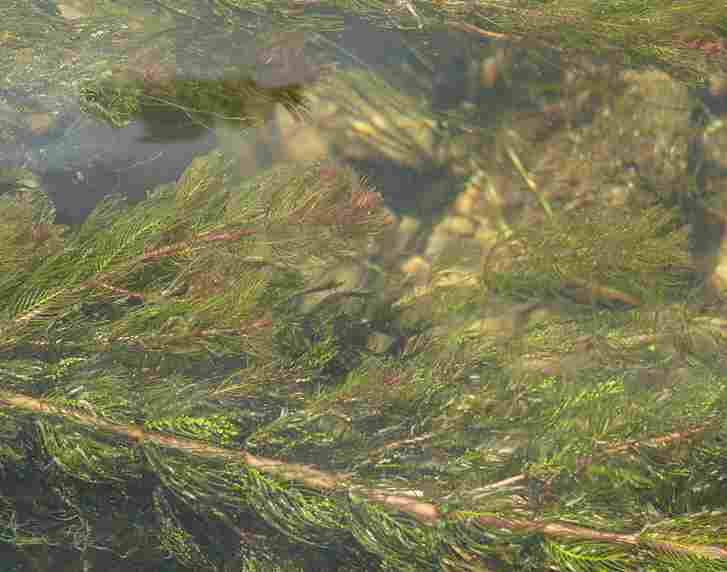
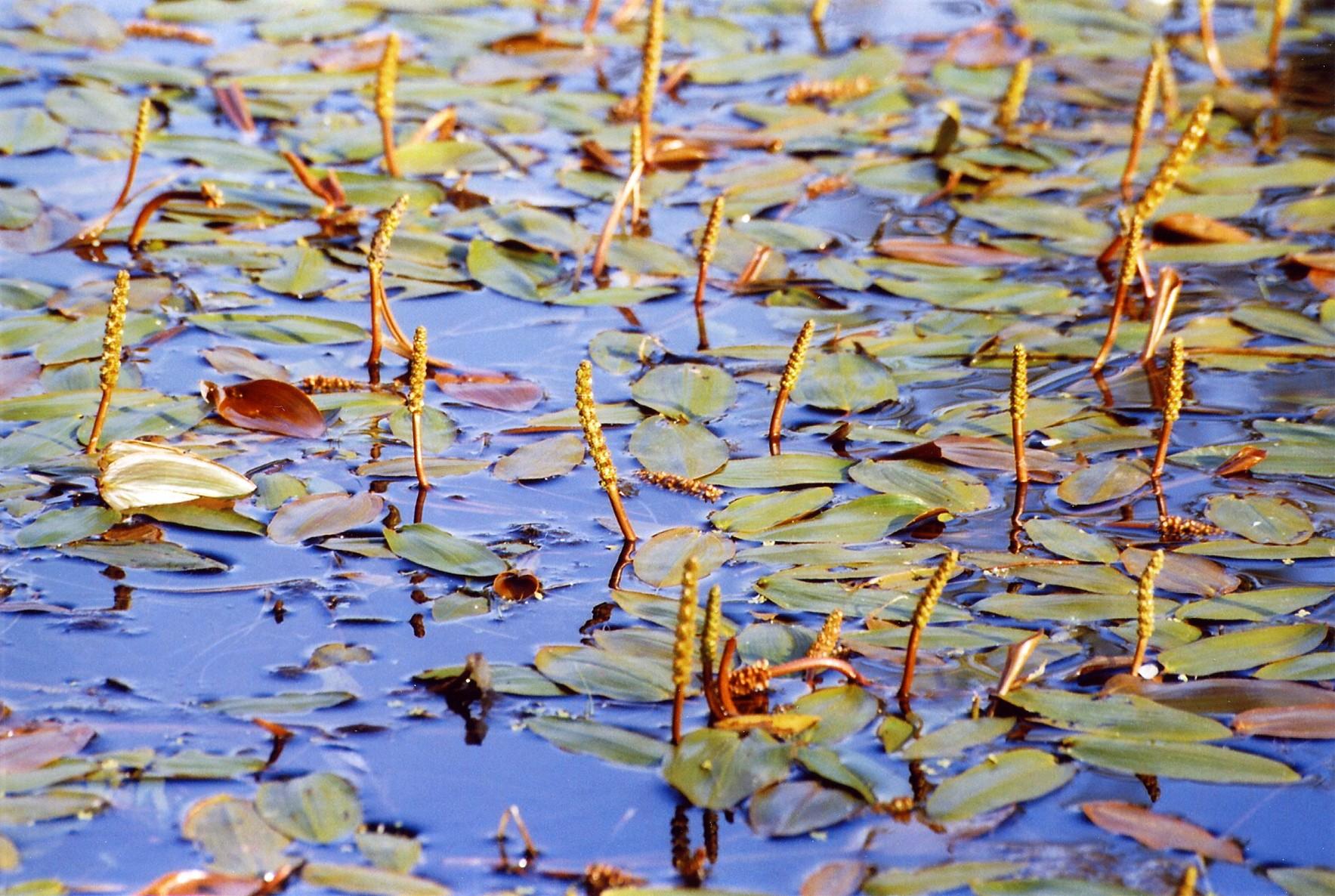
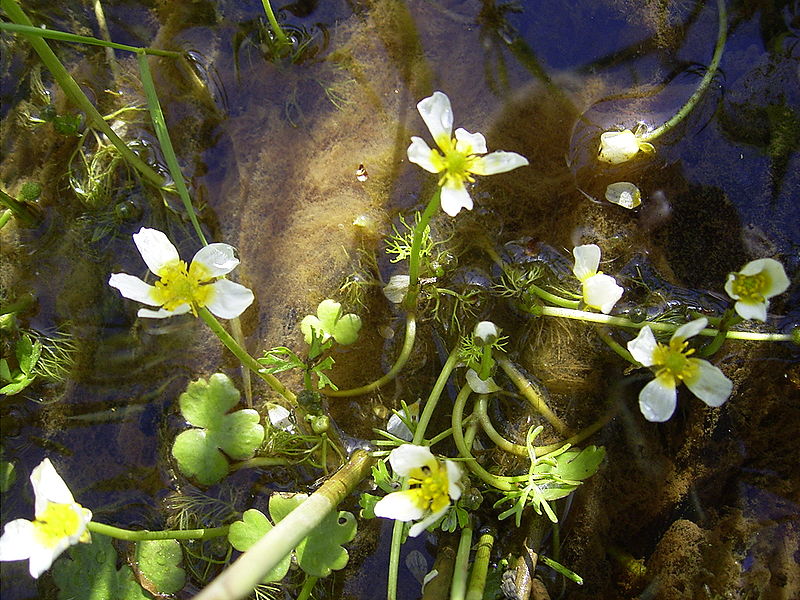
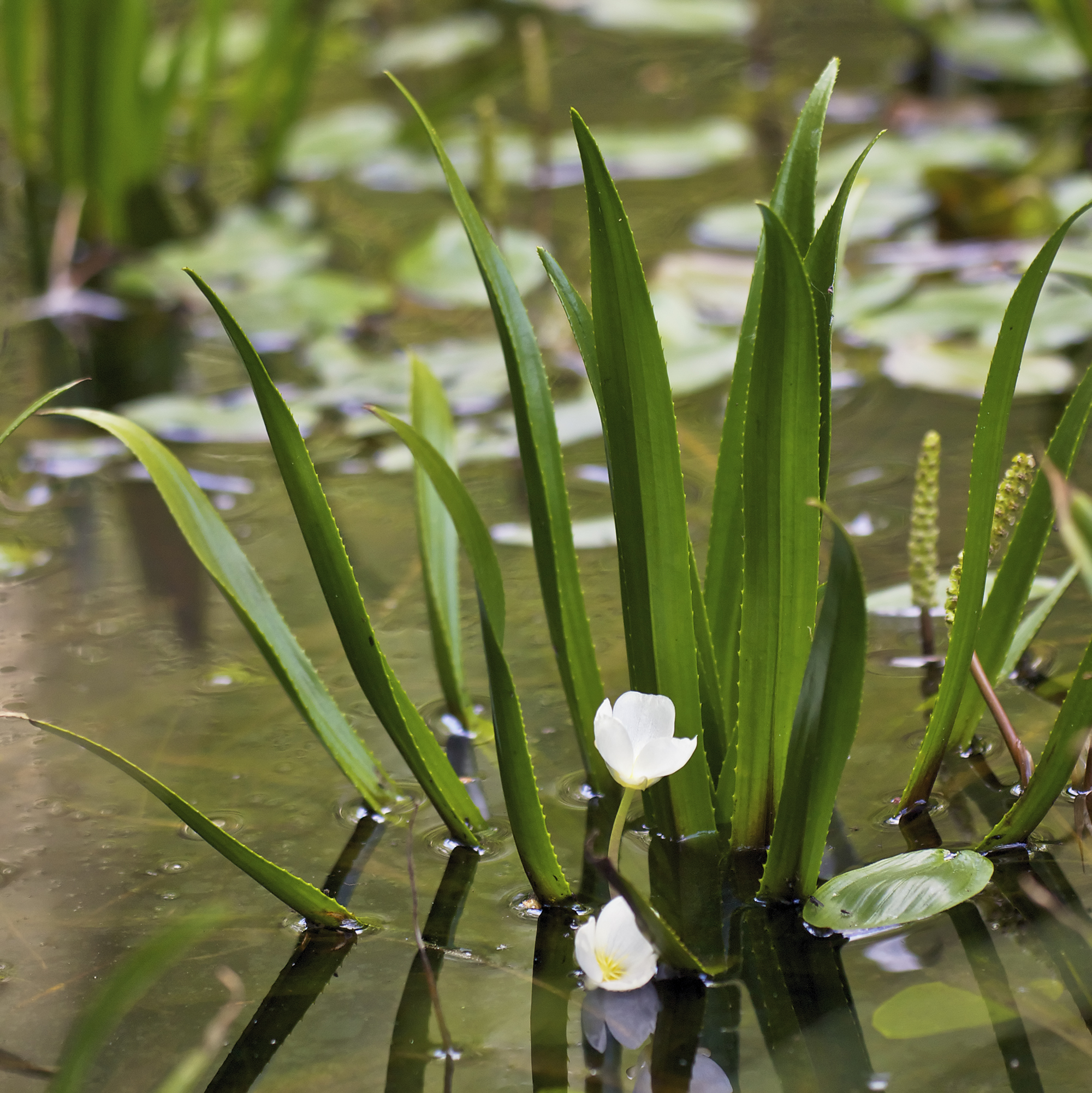
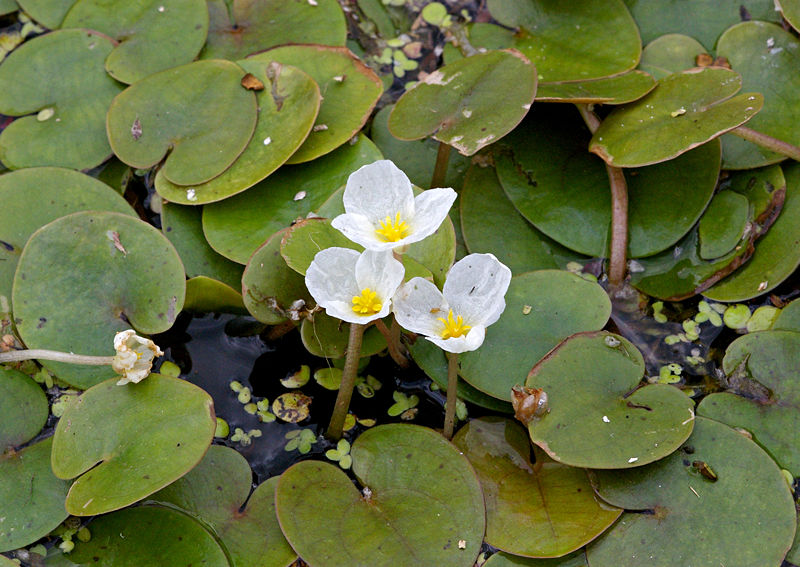
Four native floating plants. Top left: Broad-leaved pondweed Potamogeton natans Top right: Water crowfoot Ranunculus aquatilis. Bottom left: Water soldier Stratiotes aloides and bottom right: Frogbit Hydrocharis morsus-ranae.
Above: two views of the lovely native Bogbean Menyanthes trifoliata. It is an excellent plant, but keen to occupy the whole pond surface, and to climb out and root in the bog garden.
Emergents
These are plants that are rooted on the bottom, but their stems, leaves and flowers emerge from the water grow upwards away from it. Generally these should be planted around the pond edges where water is relatively shallow. These will be typically planted around the pond margins. You don't need too many, especially the taller ones, in small garden ponds.
Especially beware planting the lovely Norfolk reed Phragmites australis or the native Reed-mace Typha latifolia unless you own a modest country estate. Both are very vigourous, invasive and hard to remove once established. The reed even climbs out of the pond and tries to take over your lawn. Here are two photos to give an idea of how much of a pain they can be:
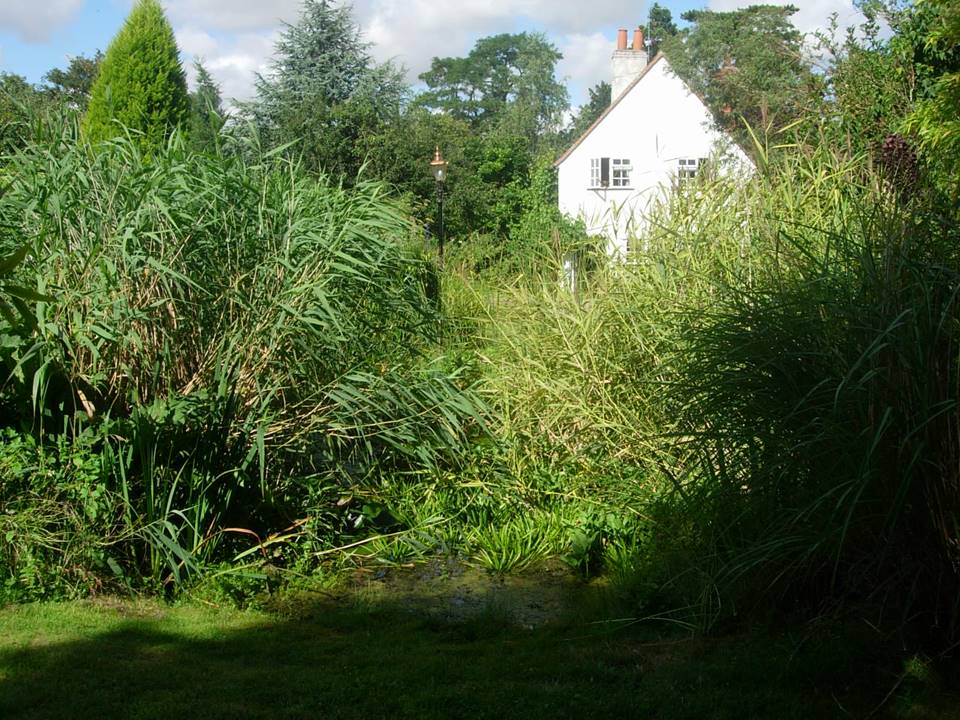
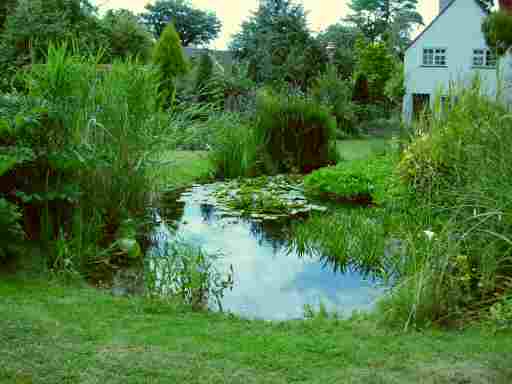
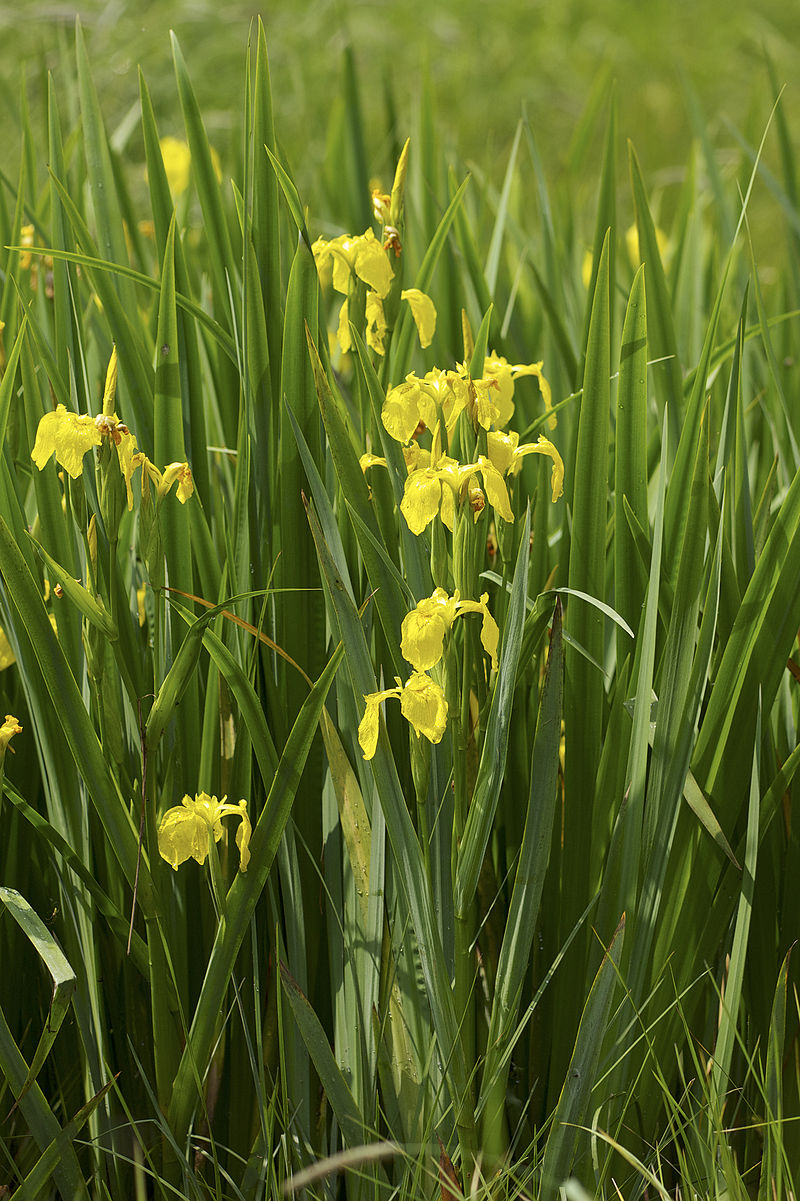
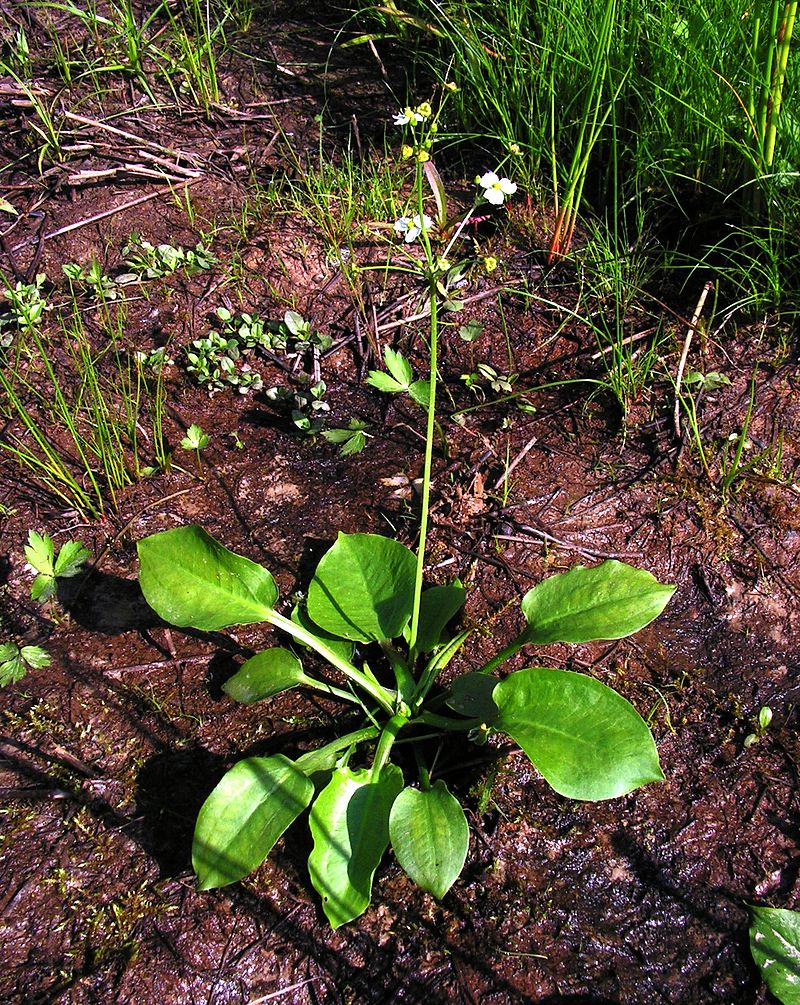
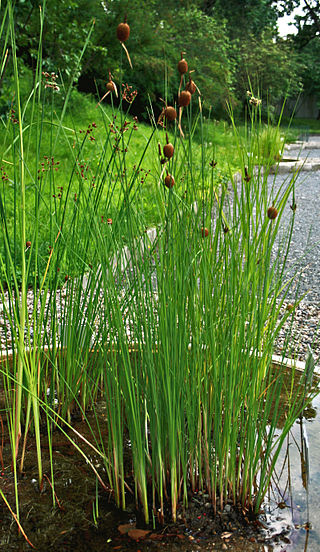
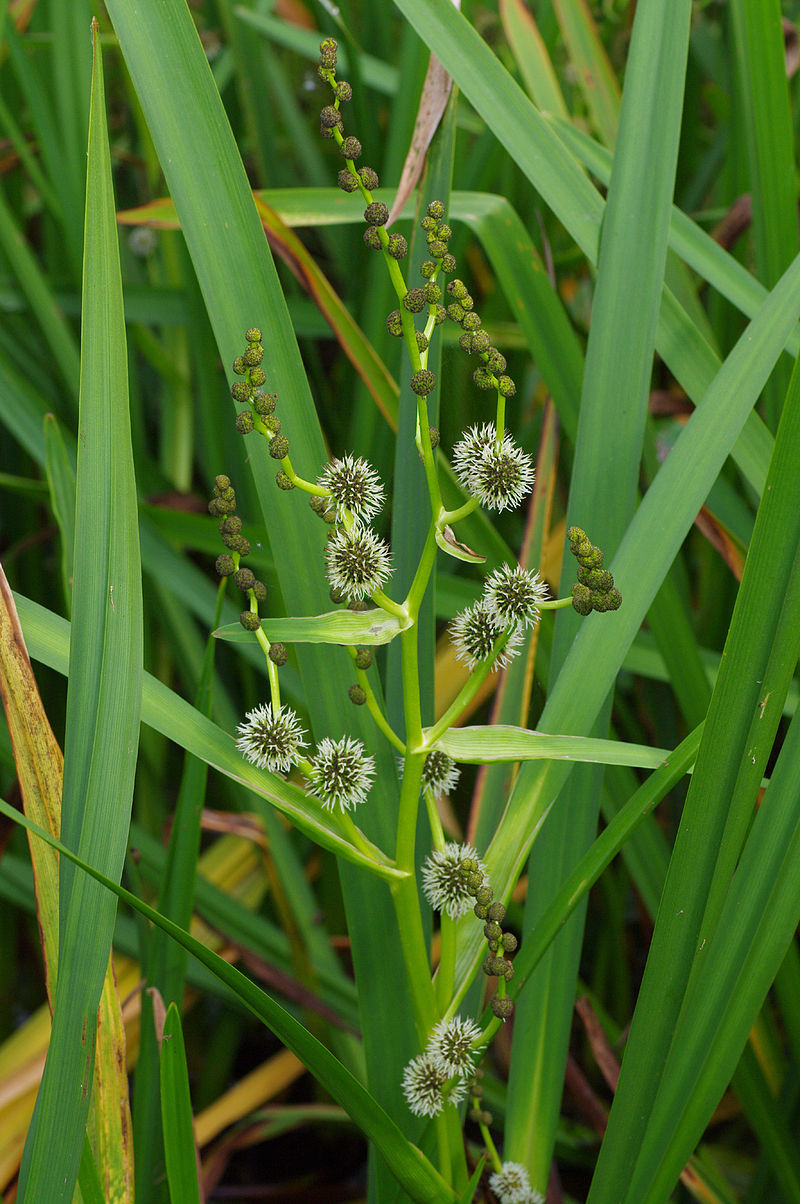
Emergents for the pond. Top left: Yellow flag iris Iris pseudocorus. Centre: Dwarf reed mace Typha minima - an introduced species much less invasive than the native T. latifolia. Right: Burr read Sparganium erectum. Bottom left: Water plantain Alisma plantago-aquatica. Centre: Flowering rush Butomus umbellatus - which isn't a rush! Right: Water mint Mentha aquatica, a pervasive plant which is quite easy to control.
Marginal Plants
These are the many species of plants which live at the edge of the pond, in wet and boggy ground rather than standing water. In practice many emergents like water mint and reeds will clamber out of the pond, while some marginals such as flote grass Glyceria fluitans and water forget-me-not Myosotis scorpioides can survive and spread in shallow water. All of the marginal plants can also serve as plants for the bog garden. One particular tip is to allow the lawn grasses at the edge of the liner to spread over into the pond. This makes a pleasing gentle transition from land to water, and makes it very easy for the smallest creatures to get in and out of the pond.
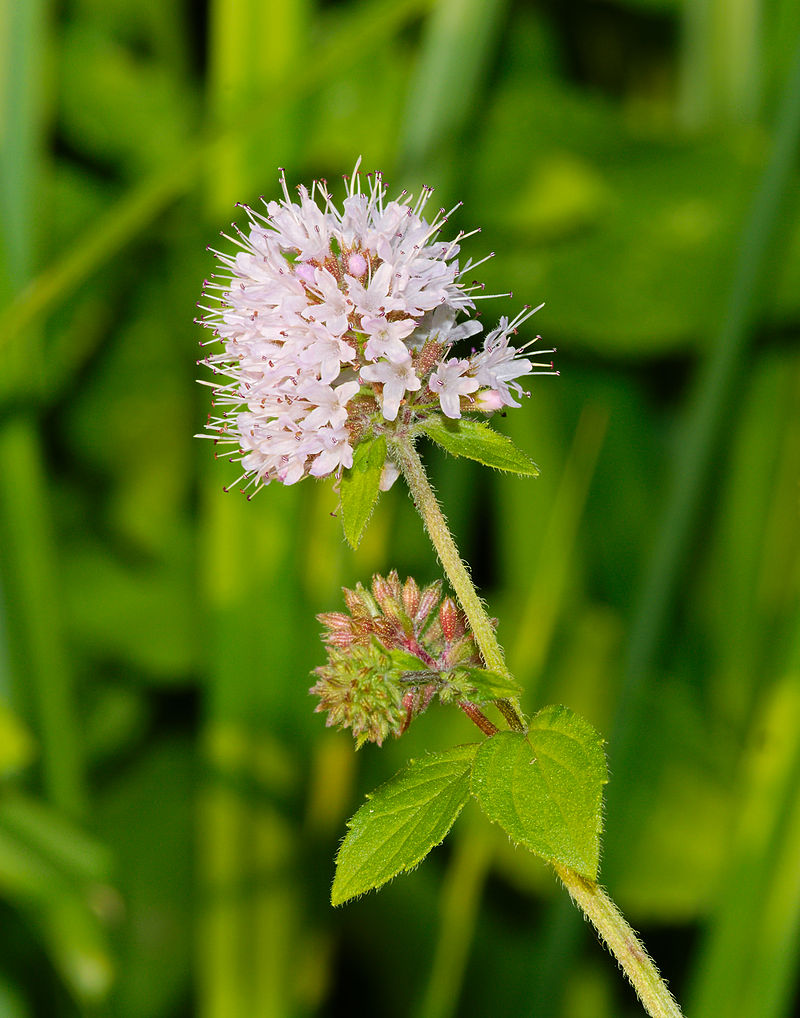
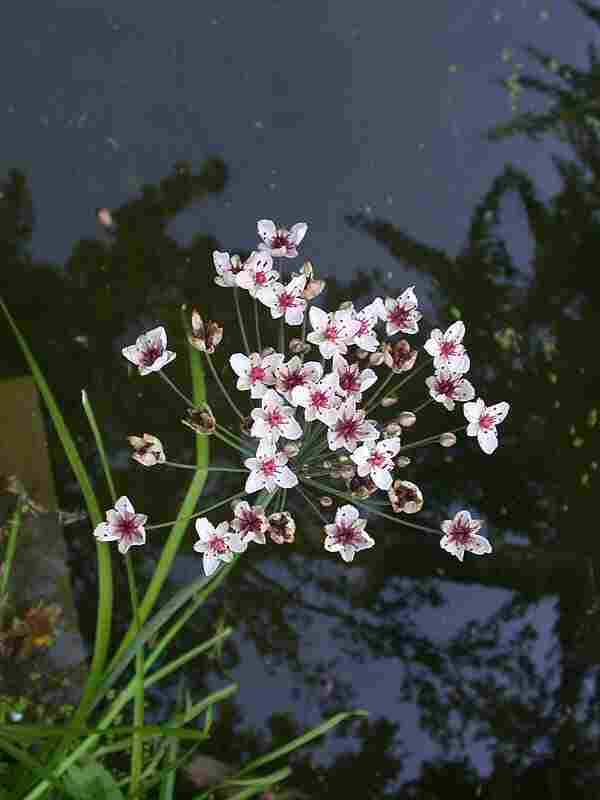
![By Frank Vincentz (Own work) [GFDL (http://www.gnu.org/copyleft/fdl.html) or CC-BY-SA-3.0 (http://creativecommons.org/licenses/by-sa/3.0/)], via Wikimedia Commons](images/Eupatorium_cannabinum_02_ies.jpg)
![I, Manfred Heyde [GFDL (http://www.gnu.org/copyleft/fdl.html), CC-BY-SA-3.0 (http://creativecommons.org/licenses/by-sa/3.0/) or CC BY-SA 2.5-2.0-1.0 (http://creativecommons.org/licenses/by-sa/2.5-2.0-1.0)], via Wikimedia Commons](images/Lythrum_salicaria_Rhine.jpg)
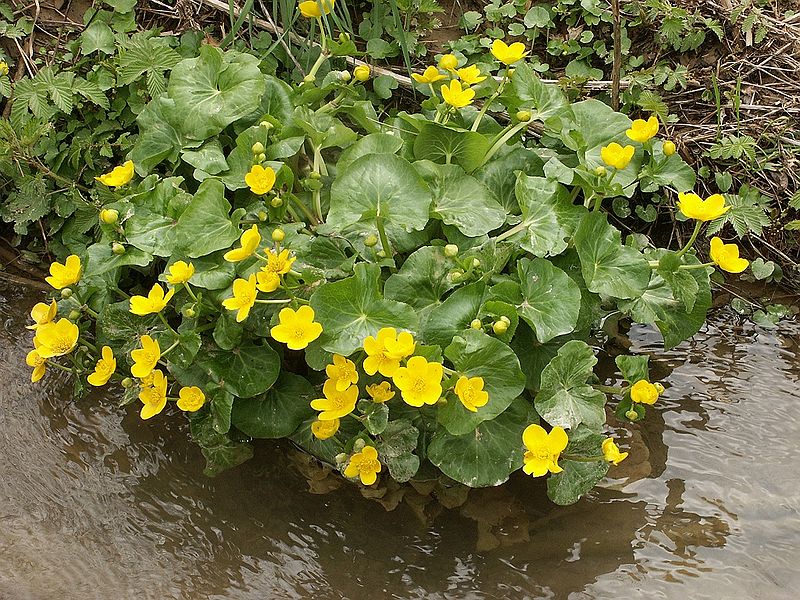
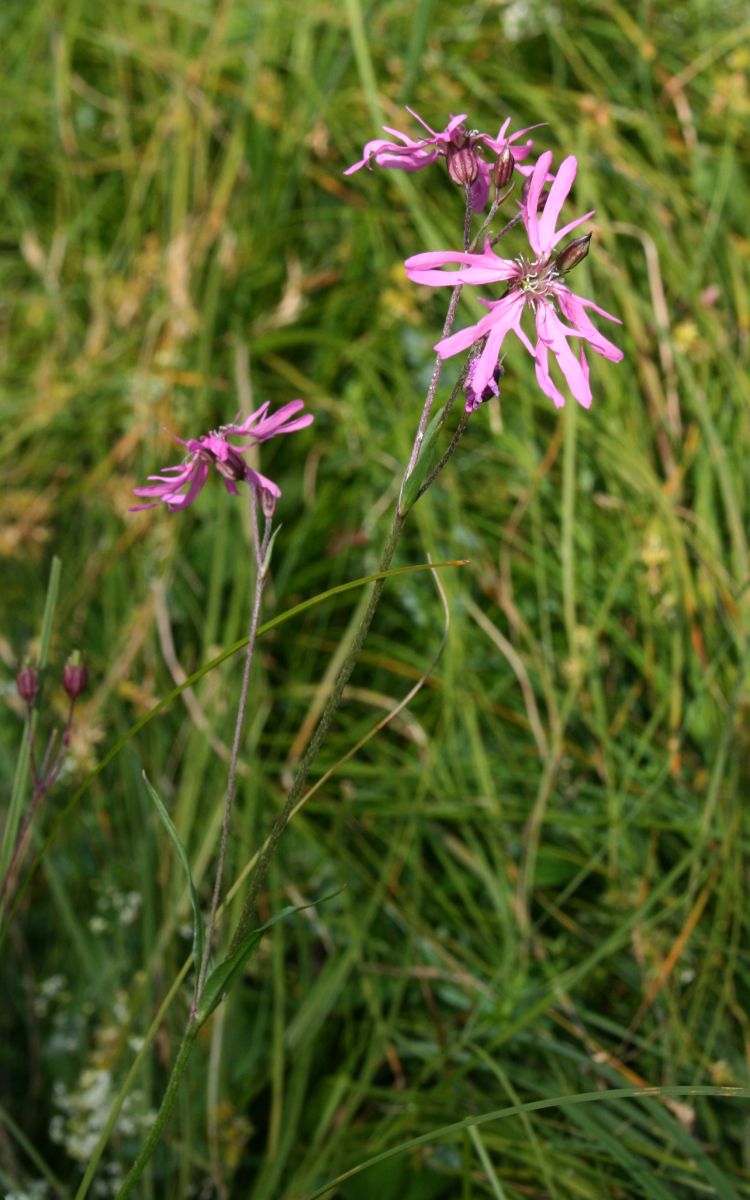
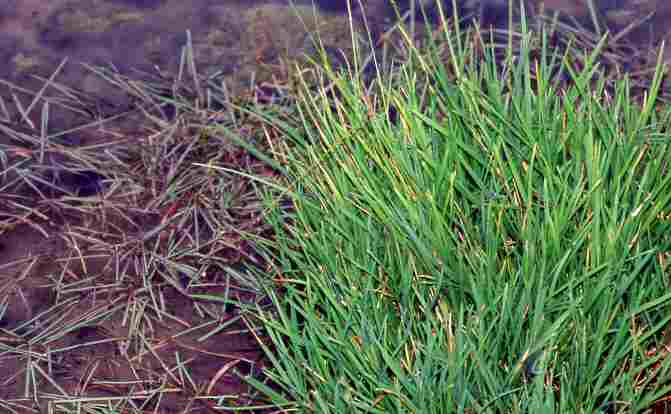
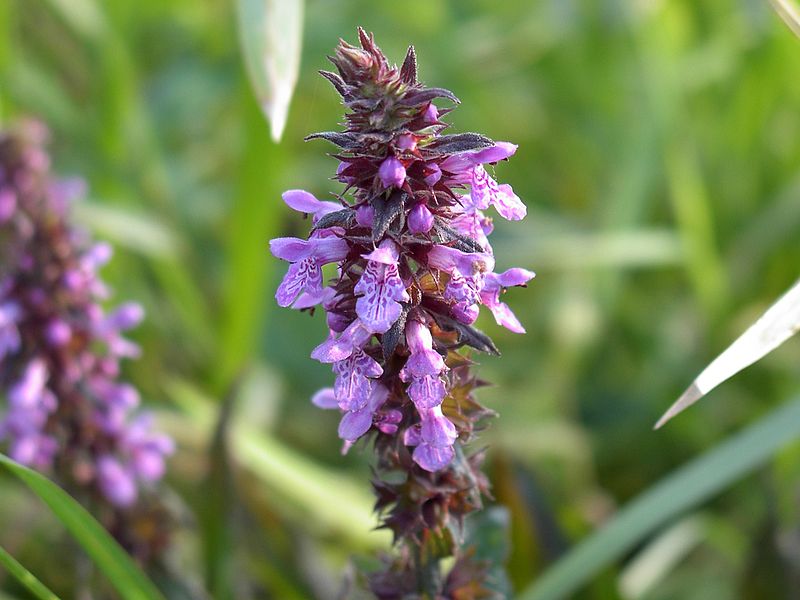
Top left: Ragged robin Lychnis flos-cuculi. Top centre: Purple loosestrife Lythrum salicaria. Top right: Marsh-marigold Caltha palustris. Above centre: Hemp agrimony Eupatorium cannabinum. Above right: Marsh woundwort Stachys palustris. Bottom left: Small sweet-grass or flote grass Glyceria fluitans.

Two useful submerged plants, Hornwort Ceratophyllum demersum (left) which is completely submerged and has curiously hard brittle leaves, and Spiked water-milfoil Myriophyllum spicatum which produces red flowers just above the surface. Don't mix the latter up with the closely related Parrot's feather which is a banned invasive species. Another to avoid is Canadian pondweed Elodea canadensis which isn't on the banned list, but is a common problem and considered an invasive species in Scotland.
Floating plants
Thes are plants which may be rooted on the bottom (or free floating) with leaves that float flat on the surface. One plant, Water soldier is unattached and spends the winter submerged, then surfaces like a spiky submarine in spring and summer, before sinking down again as winter approaches. This category includes the charismatic water lilies, but be careful, for most are too vigourous for a small pond. Miniature lilies are available, such as many varieties of Nymphaea pygmaea. Also among the floating plants are the native duckweeds, charming tiny plants that proliferate in huge numbers under some conditions and are considered a problem by many gardeners.
Planting-up ponds
By Ian Thornhill and Adrian Thomas Reviewed by Steve Head
Ponds need plants. To be visually attractive as well as a good habitat for animals, ponds need to have a good quantity of vegetation of several varieties. The only ponds that don't need plants are essentially out-door fish tanks that people maintain with pumps and filters to house koi carp.
Plants provide food, shelter, nutrient removal services and even oxygen so that aquatic animals can thrive. When they die back, their decay ensures that the next generation of plants have substrate and fertiliser from which to succeed. Much as we may like looking into the limpid depths of open water, the tiny and tasty animals that live in your pond much prefer the shelter of vegetation, so most of the animal life in ponds is in the shallow water at the edges where plants grow best, and they can hide in complex networks of roots and stems
You don't in theory need to plant-up a new pond, since plants will arrive in their own time, blown in as seeds, or carried on the feet of birds. New countryside ponds may best be left to mature without planting, but few gardeners will have that amount of patience.
How much cover?
There is no golden rule about how much vegetation a pond should have, but the National Amphibian Survey found that amphibians avoid extremes of vegetation coverage, occurring significantly less frequently in ponds containing either no emergent vegetation at all, or more than 75% cover. We suggest you should aim for about 50-75% of the water surface covered with vegetation. Don't spend a fortune buying plants to fill that area, they grow and expand astonishingly fast.
Natives or non-native plants?
Where terrestrial plants are concerned, we consider appropriate many non-natives a positive benefit to wildlife in the garden - see our page Gardens - native and non-native species. In ponds, this isn't so clear. Many aquatic plants can grow extremely rapidly, and not only will take over a pond completely, but can be a disaster if they find their way into the countryside where if they have no natural controls, they can become massive problems. See below for more warnings on this. Be aware though that many native plants such as Norfolk reed and reed-mace are also far too vigourous for normal garden ponds.
There are a large number of extremely attractive and garden-worthy native plants at our disposal, and we recommend that you primarily use these in your garden. There are non-natives that are safe to use, especially among the marginal plants, and some are very attractive. If in doubt, look up a potential non-native on offer to see if it associated with problems. Plantlife has a useful leaflet listing useful native and non-native pond plants as well as flagging up ones to avoid.
For detailed planting advice, look at Ian Thornhill's leaflet "Planting up". What follows here is a brief introduction to water plant types.
Submerged plants
These plants have their leaves and stems beneath the water surface and only the flowers emerge above. They are rooted onto the bottom, or tangled up with the roots of other plants. You will see these described as "oxygenators" at garden centres, but their role in providing oxygen is less important than their creation of habitat for invertebrates. Most submerged plants grow very fast, and can usefully mop-up excessive nutrients, which you then remove from the pond as you thin-out the plant growth. In productive eutrophic ponds hornwort in particular can grow very fast and almost fill the open water below the surface.
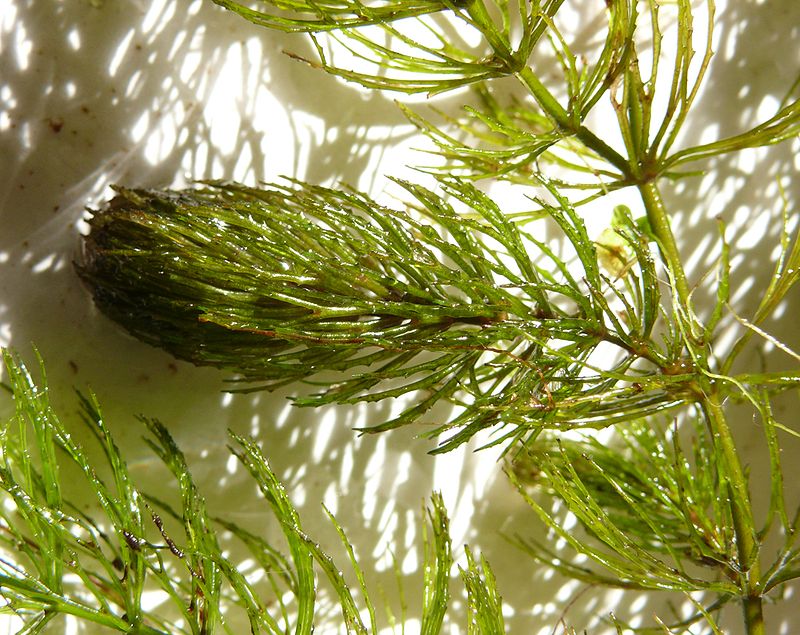

Above: Two useful submerged plants, Hornwort Ceratophyllum demersum (left) which is completely submerged and has curiously hard brittle leaves, and Spiked water-milfoil Myriophyllum spicatum which produces red flowers just above the surface. Don't mix the latter up with the closely related Parrot's feather which is a banned invasive species. Another to avoid is Canadian pondweed Elodea canadensis which isn't on the banned list, but is a common problem and considered an invasive species in Scotland.
Floating plants
Thes are plants which may be rooted on the bottom (or free floating) with leaves that float flat on the surface. One plant, Water soldier is unattached and spends the winter submerged, then surfaces like a spiky submarine in spring and summer, before sinking down again as winter approaches. This category includes the charismatic water lilies, but be careful, for most are too vigourous for a small pond.
Miniature lilies are available, such as many varieties of Nymphaea pygmaea. Also among the floating plants are the native duckweeds, charming tiny plants that proliferate in huge numbers under some conditions and are considered a problem by many gardeners.




Above: Four native floating plants. Top left: Broad-leaved pondweed Potamogeton natans Top right: Water crowfoot Ranunculus aquatilis. Bottom left: Water soldier Stratiotes aloides and bottom right: Frogbit Hydrocharis morsus-ranae.

Above: two views of the lovely native Bogbean Menyanthes trifoliata. It is an excellent plant, but keen to occupy the whole pond surface, and to climb out and root in the bog garden.
Emergents
These are plants that are rooted on the bottom, but their stems, leaves and flowers emerge from the water grow upwards away from it. Generally these should be planted around the pond edges where water is relatively shallow. These will be typically planted around the pond margins. You don't need too many, especially the taller ones, in small garden ponds.
Especially beware planting the lovely Norfolk reed Phragmites australis or the native Reed-mace Typha latifolia unless you own a modest country estate. Both are very vigourous, invasive and hard to remove once established. The reed even climbs out of the pond and tries to take over your lawn. Here are two photos to give an idea of how much of a pain they can be:

Steve Head's pond - 2005
Steve Head's pond - 2007






Emergents for the pond. Top left: Yellow flag iris Iris pseudocorus. Centre: Dwarf reed mace Typha minima - an introduced species much less invasive than the native T. latifolia. Right: Burr read Sparganium erectum. Bottom left: Water plantain Alisma plantago-aquatica. Centre: Flowering rush Butomus umbellatus - which isn't a rush! Right: Water mint Mentha aquatica, a pervasive plant which is quite easy to control.
Marginal Plants
These are the many species of plants which live at the edge of the pond, in wet and boggy ground rather than standing water. In practice many emergents like water mint and reeds will clamber out of the pond, while some marginals such as flote grass Glyceria fluitans and water forget-me-not Myosotis scorpioides can survive and spread in shallow water. All of the marginal plants can also serve as plants for the bog garden. One particular tip is to allow the lawn grasses at the edge of the liner to spread over into the pond. This makes a pleasing gentle transition from land to water, and makes it very easy for the smallest creatures to get in and out of the pond.
![By Frank Vincentz (Own work) [GFDL (http://www.gnu.org/copyleft/fdl.html) or CC-BY-SA-3.0 (http://creativecommons.org/licenses/by-sa/3.0/)], via Wikimedia Commons](images/Eupatorium_cannabinum_02_ies.jpg)
![I, Manfred Heyde [GFDL (http://www.gnu.org/copyleft/fdl.html), CC-BY-SA-3.0 (http://creativecommons.org/licenses/by-sa/3.0/) or CC BY-SA 2.5-2.0-1.0 (http://creativecommons.org/licenses/by-sa/2.5-2.0-1.0)], via Wikimedia Commons](images/Lythrum_salicaria_Rhine.jpg)



Marginal plants.
Top left: Ragged robin Lychnis flos-cuculi.
Top centre: Purple loosestrife Lythrum salicaria.
Top right: Marsh-marigold Caltha palustris. Above centre: Hemp agrimony Eupatorium cannabinum.
Above right: Marsh woundwort Stachys palustris.
Bottom left: Small sweet-grass or flote grass Glyceria fluitans.

Problem plants
Some native water plants, such as the 'bulrushes' Typha latifolia, have roots that are capable of piercing through thin liners. Typha also fixes nitrogen, increasing nutrient levels in ponds. Some waterplants are much too vigorous for small ponds; most water lilies in particular will overwhelm a small pond, but are quite easily controlled. The common reed Phragmites australis is emblematic of marshes but far too vigourous for typical garden ponds.
Invasive plants
Almost all of the major problems with invasive aquatic plants in the UK have come from pond plants that have 'escaped' or being dumped in wild habitats and then run amok. Find out more about this problem in our leaflet Ponds and the Law and on the Be Plant Wise website, and see our general page on problem plants Plants to avoid.
Five are now banned from sale in the UK and should be avoided at all costs:
Azolla filiculoides Water Fern
Crassula helmsii Australian Swamp Stonecrop/New Zealand Pygmyweed
Hydrocotyle ranunuculoides Floating Pennywort
Ludwigia grandiflora Water Primrose
Myriophyllum aquaticum Parrot's Feather
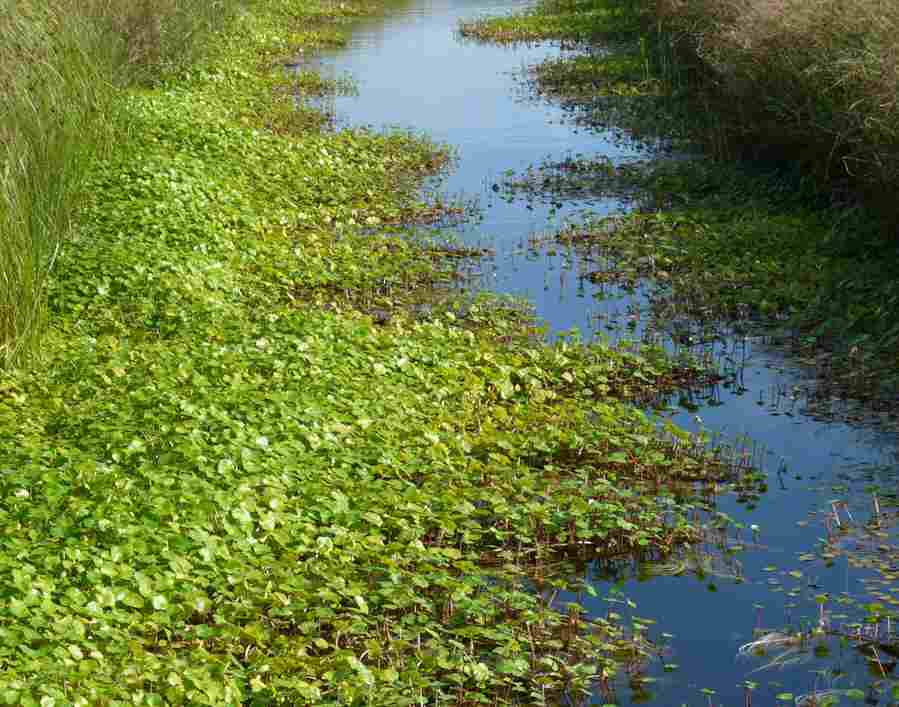
Floating Pennywort clogging a ditch in a wetland habitat. This is only one of a number of aquatic escapees from garden ponds that are causing huge problems in sensitive biodiversity sites.

Floating Pennywort clogging a ditch in a wetland habitat. This is only one of a number of aquatic escapees from garden ponds that are causing huge problems in sensitive biodiversity sites.
Resources available from this page:

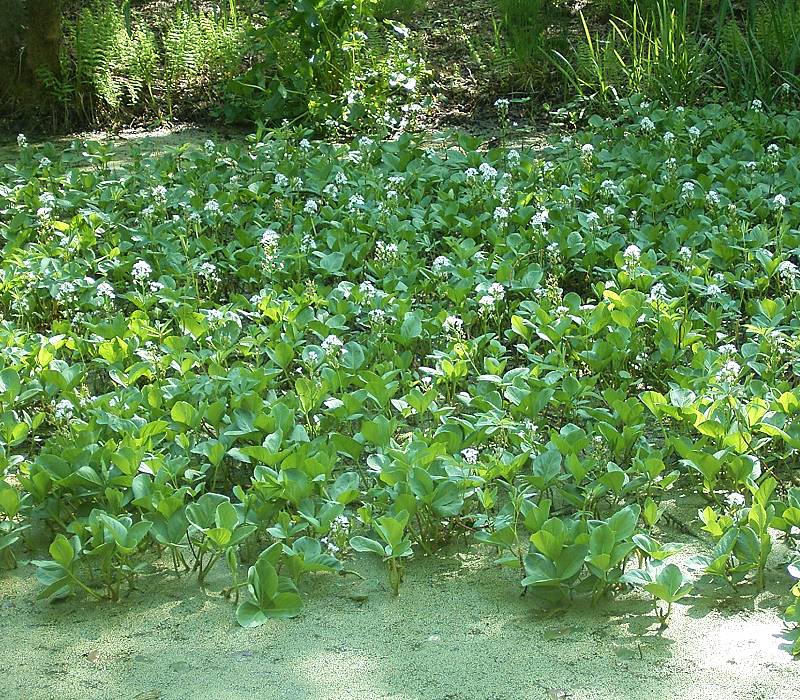
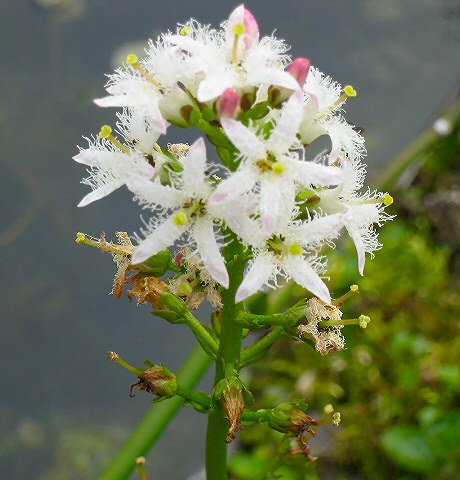


- Home
- Practical Advice
- Garden habitats
- Water
- Planting-up ponds











